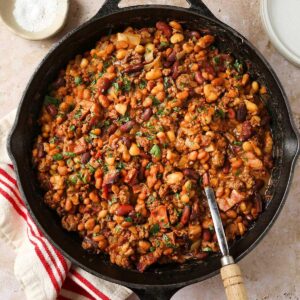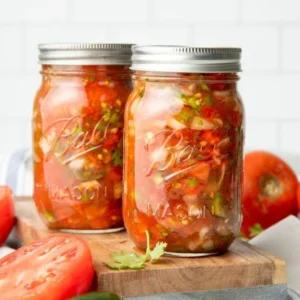Chinese eggplant, also known as Asian eggplant, is a vibrant and tasty vegetable commonly used in Chinese cuisine. With its smooth, tender skin and creamy flesh, it offers a slightly sweeter and less bitter flavor than its Western counterparts. This dish is special because it combines savory ingredients like soy sauce, garlic, and ginger, making it an umami-packed delight. Whether you’re looking for a quick meal or a vegetarian main dish, Chinese eggplant recipes can be tailored to suit various tastes, offering endless possibilities for customization.
Ingredients
-
2 medium Chinese eggplants (about 1 lb or 450g), cut into 2-inch pieces
-
2 tablespoons vegetable oil (for frying)
-
3 cloves garlic, minced
-
1-inch piece of ginger, grated
-
1/4 cup soy sauce (low-sodium recommended)
-
2 tablespoons rice vinegar
-
1 tablespoon brown sugar (or coconut sugar for a healthier alternative)
-
1 tablespoon hoisin sauce (optional for a sweeter flavor)
-
1/4 teaspoon chili flakes (optional for spice)
-
1 tablespoon sesame oil
-
2 tablespoons chopped green onions (for garnish)
-
1 tablespoon sesame seeds (optional)
Substitutions:
-
If you prefer a gluten-free version, use tamari or coconut aminos instead of soy sauce.
-
For a low-carb option, replace sugar with stevia or monk fruit.
-
You can use any oil you prefer, though peanut oil is a great choice for authentic flavor.
Step-by-Step Cooking Instructions
-
Prep the Eggplants: Start by cutting the Chinese eggplants into 2-inch pieces. If the eggplants are large, you can cut them into half-moons or thick strips, depending on your preference.
-
Heat the Oil: In a large pan, heat 2 tablespoons of vegetable oil over medium-high heat. Once hot, add the eggplant pieces in a single layer. You may need to do this in batches to ensure even cooking.
-
Fry the Eggplant: Fry the eggplant pieces for about 3-4 minutes per side, or until golden brown and tender. Remove the cooked eggplant and set it aside on a paper towel-lined plate to drain excess oil.
-
Prepare the Sauce: In the same pan, add minced garlic and grated ginger. Sauté for about 30 seconds, until fragrant. Then, add the soy sauce, rice vinegar, brown sugar, hoisin sauce (if using), and chili flakes. Stir well to combine, and let it simmer for 2-3 minutes, allowing the sauce to thicken slightly.
-
Combine Eggplant with Sauce: Add the fried eggplant back into the pan with the sauce, tossing gently to coat each piece evenly. Drizzle sesame oil over the mixture for an extra layer of flavor. Cook for an additional 2 minutes, ensuring the eggplant absorbs the sauce.
-
Garnish and Serve: Transfer the cooked eggplant to a serving dish and sprinkle with chopped green onions and sesame seeds for garnish.
Pro Tips and Cooking Techniques



-
Avoid Overcrowding the Pan: When frying the eggplant, make sure not to overcrowd the pan. This ensures the eggplants crisp up and don’t become soggy.
-
Use Fresh Eggplant: Fresh Chinese eggplant is best for this recipe as it cooks more evenly and has a delicate taste. Older eggplants can become bitter.
-
Soy Sauce Variations: For a richer taste, consider using dark soy sauce instead of light soy sauce, but reduce the amount as it’s saltier.
Variations and Customizations
-
Vegetarian: This recipe is already vegetarian! Feel free to add tofu cubes for added protein.
-
Spicy: For a more fiery dish, increase the amount of chili flakes or add fresh sliced chilies while cooking.
-
Gluten-Free: Ensure that your soy sauce is gluten-free (tamari works well) and substitute the hoisin sauce with a gluten-free alternative.
-
Low-Carb: Replace the brown sugar with a natural low-carb sweetener like erythritol or stevia.
-
Fusion: Try adding a sprinkle of curry powder for an Indian-inspired twist, or top with fresh cilantro for a fresh burst of flavor.
Serving Suggestions
-
Serve Chinese eggplant over a bed of steamed jasmine rice or quinoa for a balanced meal.
-
Pair it with other vegetable dishes like stir-fried bok choy or steamed broccoli.
-
For a complete meal, consider serving it alongside crispy dumplings or spring rolls.
-
A light, chilled cucumber salad with a tangy vinaigrette would complement the richness of this dish perfectly.
Nutritional Information (Per Serving)
-
Calories: 220
-
Protein: 3g
-
Carbs: 15g
-
Fats: 18g
-
Fiber: 5g
-
Sugar: 7g
This breakdown can vary depending on the specific ingredients used (like hoisin sauce or sugar substitutes).
Frequently Asked Questions (FAQs)
1. Can I make this recipe without frying the eggplant?
Yes! You can roast the eggplant instead. Toss it with a little oil and bake at 400°F (200°C) for about 20 minutes until tender.
2. How do I store leftovers?
Store leftovers in an airtight container in the fridge for up to 3 days. Reheat in a pan or microwave before serving.
3. Can I freeze the dish?
While the eggplant can be frozen, it may lose its texture when reheated. For the best results, store the cooked eggplant without the sauce and freeze it separately. Add fresh sauce when reheating.
Closing Thoughts
Chinese eggplant is a versatile and delicious vegetable that can be easily transformed into a flavorful dish. Whether you stick to the classic recipe or customize it to your preferences, this dish is sure to please. Have fun experimenting with different variations, and don’t forget to share your results!



